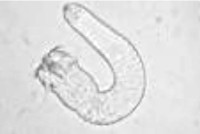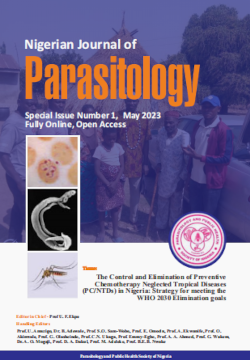Prevalence of endoparasites of field crickets (Brachytrupes membranaceous) in the eastern zone of Kogi State, north-central, Nigeria
http://dx.doi.org/10.4314/njpar.v40i1.10
Keywords:
Nigeria, eastern Kogi, parasites, helminthes, CricketsAbstract
Field crickets belong to the family; Gryllidae (insect: orthoptera), with flattened bodies and long antennae. They are omnivores and scavengers that normally feed on organic materials as well as decaying plant materials. A survey of the endoparasites of field crickets (Brachytrupes membranaceous) in the eastern zone of Kogi State, north-central Nigeria, was undertaken between April and June, 2016. A total of 150 field crickets (Brachytrupes membranaceous) were collected at nine locations and were dissected in petriplates. The midgut region of the alimentary canal dissected and examined for parasites. Out of the 150 samples examined, 64 (42.6%) had different types of parasites. The gut parasites encountered were 14(9.3%) Spinochordodes sp., and 50 (33.3%) Paragordius sp. The highest prevalence was observed in May, while the male Field Crickets were most affected. The results observed in the present study suggest that field crickets normally consumed as a special delicacy in this area, might be a potential reservoir for zoonotic parasites. There is need for intensive public health enlightenment on the danger of consuming raw or improperly prepared field crickets.
References
Addie, T.2013. Want to help solve the global food crisis eat more crickets. Forbes.
Adedire, C. O. 2011. Insect science, global food security and environmental health. Nigeria Journal of Entomology, 28:1-6.
Adedire, C. O. and Aiyesanmi, A. F. 1999. Proximate and mineral composition of the adult and immature forms of the variegated grasshopper, Zonocerus variegates (L.) Bioscience Research Communications,11: 121-126.
Alexander, R.D. 1961. Aggressiveness, territoriality and sexual behaviour in field crickets (Orthoptera: Gryllidae). Behaviour, 17:130-223.
Alexander, R. D. 1968. Life cycle origins speciation and related phenomena in crickets. Quarterly Review of Biology, 43: 1-41.
Ali-Kham, F. E. A., Ali-Khan, Z. 1977. Paragordius varius (Leidy) Nematomorpha infection in man: A case report from Quebec (Canada). Journal of Parasitology, 63:174-176.
Amatobi, C. I. 2007. Arthropod pests of crops in Nigeria: General biology, natural enemies and control. Ndahi Printing Press, Zaria, Nigeria, pp. 31-35. ISBN -978- 2741-43-4.
Ashok, E. D., Bhamre, P.R. 2012. Novel gut bacterial fauna of Gryllotalpa Africana beau (Orthoptera: Gryllotalpidae). International Journal of Life Sciences, 6(1): 51-55.
Banjo, A. D., Lawal, O. A. and Sangonuga, E. A. 2000. The nutritional value of fourteen species of edible insects in Suth, Western Nigeria. African Journal of Biotechnology, 5(3): 298-301.
Belluco,S., Losasso, C., Maggioleth, M., Alonzi, C.C., Paoleth, M. and Ricci, A. 2013. Edible insects in a food safety and nutritional perspective: A critical review. Comprehensive Reviews in the Food Science and Food Safety, 12(3): 296-313.
Bodenheimer, G. F.S. 1951. Insects as human food. The Hague: W. Junk (ed.), pp. 352-354.
Boggs, C. L., Inouye, D. W. 2012. A single climate driver has direct and indirect effects on insect population dynamics. Ecology Letters, 15: 502-508.
Buttiker, W. W., Bunzli, G. H. 1958. Biological notes on Brachytrupes membranceous (Dru.) (Orthopt., Gryllidae), in Southern Rhodesia. Bulletin of Entomological Research, 48 (1): 49-57.
CISR. 2014. Entomophagy (Eating insects). Centre for Invasive Species Research, University of California. Retrieved 27 January, 2014.
Duron, O., Bouchon, D., Boutin, S., Belamy, L., Zhou, L. 2008. The diversity of reproductive parasite among arthropods: Wolbachia do not walk alone. Trends in Genetics, 6:27-30. Ene, J. C. 1963. Insects and man in West Africa. Ibadan, Nigeria: Ibadan Unversity Press Ltd, pp. 5-15.
Eutick, M. L., O’Brien, R. W., and Staytor, M. 1978. Bacteria and parasites from the gut of Australian termites. Applied Environmental Microbiology, 35: 823- 828.
FAO. 2013. Edible insect future prospects for food and feed security. FAO, Rome. ISBN 978-92-107595-1.
Gahukar, R. T. 2011. Entomophagy and human food security. International Journal of Tropical Insect Science, 31(3):129-144.
Gordon, D. G. 1998.The eat-a-bug cookbook. Berkley, California: Ten Speed Press. ISBN 0-89815-977-6.
Gorochov, A. V. and Mostovski, M. B. 2008. Apterous crickets of the tribe Gryllini from South Africa and Nambia (Orthoptera: Gryllidae). African Invertebrates, 49(1):109-120.
Gouli, V., Gouli, S., Marcelino, J. 2011. Common infections diseases of insects in culture: Diagnostic and prophylactic methods. Briefs in Animal Sciences. Springer.Retrived 04-January-2012.
Hanelt, B., Thomas, F., and Schmidt-Rhaesa, A. 2005. Biology of the Phylum Nematomorpha. Advances in Parasitology, 59:244-305.
Holt, V.M. 1969. Why not eat insects? Classey Publishing Ltd, England, p. 15.
Jochmann, R., Schimdt-Rhaesa, A 2007. New ultrastructural data from the larva of Paragordiusvarius (Nematomorpha). Acta Zoologica, 88(2):137-147.
Kagei, N., Oshima, T., Inoue, I., Kumasaki, T. 1966. First human case on Gordiid worm in Japan (Nematomorpha: Gordiidae). Japanese Journal of Parasitology, 15:79-81 (in Japanese).
Kruse, M, Kwon, C 2004. Edible insect: Important source of protein in Central Africa. Rome: Forestry Information Office, FAO/UN.
Lee, K. J. Baer, Y. T., Kimm D. H., Deung, Y. K., Ryang, Y. S., Im, K. I. and Yong, T. S. 2003. A gordius worm found in a 3-year-old girl’s vomitus in China. Yonse Medical Journal, 44:557-560.
Ogedengbe, A. B. O. and Rotimi, J. 2004. A survey of edible insects in the Niger Delta Region of Nigeria. Nigeria Journal of Applied Science, 22:151-155.
Paiko, Y.B., Dauda, B. E. N., Suleiman, M. A. T., Akanya, H. O. and Jacob, J. O. 2013. Physico-chemical properties and metal ions contents of oil extracted from crickets (Brachytrupes membranaceous) in Bosso LGA, Niger State, Nigeria. Asian Journal of Science and Technology, 4(5): 008-012.
Poinar, Jr., G. 2008. Global diversity of hairworms (Nematomorpha: Gordiaceae) in freshwater. Hydrobiologia, 595(1): 79-83.
Poulin, R. 1995. Adaptive changes in the behaviour of parasitized animals a critical review. International Journal Parasitology, 25:1371-1383.
Poulin, R. 1996a. Sexual inequalities in helminth infections: A cost of being a male? American Nature, 147: 287-295.
Ramos-Elorduy, J., and Menzel, P.1998. Greep crawly cusine: The gourmet guide to edible insects. Inner Traditions/Bear and Company. P.44 ISB978-0- 89281- 747-4.Retrieved 2014-04-23.
Senimons, L. W., Zuk, M. 1994. Age structure of parasitized and unparasitized population of the field crickets, Teleogryllusoceanicus. Ethology, 98:333-340.
Sheridan, L. A. D., Poulin, R., Ward, D. F. and Zuk, M. 2000. Sex differences in parasitic infections among arthropod hosts: Is there a male bias? Oikos, 88: 327- 384.
Thomas, F, Schmidt-Rhaesa, A., Martin, G., Manu, C., Durand, P. and Renaud, F. 2000. Do hair worms (Nematomorpha) manipulate the water seeking behaviour of their terrestrial hosts? Journal of Evolutionary Biology, 15(3):356-361
Uchikawa, R., Akune, K., Inoue, I., Kagei, N. and Sato, A. 1987. A human case of hairworm. Japanese Journal of Parasitology, 36:358-360.
Usman, S. S. 2011. Olufia Ekeji (Igala Language Dictionary). JAS Investment Services, Anyigba, Nigeria, 343pp.
Wei, D. X. and Yang, W. Y. 1981. Parachordodes sp. (Nematomorpha) human infestation of the lower urinary tract: the first case report in China. Acta Academy of Medicine Wuhari, 1:40-45. www:// en.wikipedia.org/wiki/igala_people.
Yaacob, O. and Subhadrabandhu, S. 1995. The production of economic fruits in South-East, Asia. Kuala Lumpur. Oxford University Press.
Yamada, M., Tegoshi, T., Abe, N. and Urabe, M. 2012. Two human cases infected by the horsehair worm, Parachordodessp (Nematomorpha: Chordodidae) in Japan. The Korean Journal of Parasitology, 50(3): 263-7.
Yen, A. 2009. Edible insects: Traditional knowledge or Western Phobia. Entomological Research, 39(5): 289- 298.
Yoloye,V.L. 1994. Basic Invertebrate Zoology.3rd Edition, Codes and Quant Nig. Ltd., Lagos, Nigeria, 320pp.
Zhuikov, M. 2006. Chemically mediated host-plant selection by the Milfoil weevil: A freshwater insectplant interaction. Minnesota Sea Grant Research. Extension Service Unit, University of Minnesota seagr@d.umn.edu.
Zuk, M. 1987. The effects of gregarine parasites, body size, and time of day on spermatophore production and sexual selection in field crickets. Behaviour Ecological Sociobiology, 21:65-72.
Zuk, M., Senimons, L.W. and Cupp L. 1993. Calling characteristics of parasitized and unparasitized populations of the field crickets Teleogryllusoceanicus. Behaviour Ecology Sociobiology, 33: 339-343.

Downloads
Published
How to Cite
Issue
Section
License
Copyright (c) 2023 Nigerian Journal of Parasitology

This work is licensed under a Creative Commons Attribution-NonCommercial-NoDerivatives 4.0 International License.




